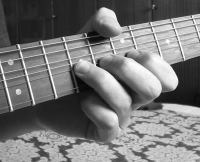Bending

Bending (to English bend "flex curve") is a common in certain styles of playing technique of the guitar . The pitch of a note is changed by acting on the string tension in order to achieve glissando or vibrato-like effects and / or an intentionally unclean intonation . Usually the effect is brought about by pulling the string. (In the musical text it can be prescribed by a B for English bend ). There are variants that are based on special mechanical adaptations of the instrument. Another way of bending is to pull or push against the guitar neck, whereby the effect affects all strings of the instrument.
Similar techniques are also used on the blues harp (harmonica) and brass players .
technology
Bending on the guitar is usually caused by pushing the strings up or pulling the strings down. This increases the string tension and the tone becomes higher. Due to the smooth transition between the source and target note can be melodies phrasing .
In the blues , approximately quarter-tone bends are common ( smear bends ), which are used by gently pulling the string (playing instruction: Sm for small bend or smear bend ) to reach the blue notes (which are between the minor and major third or seventh ). There are also semitone and whole tone bends in a large number of guitar solos .
If the drawn string is relaxed again, one speaks of backward bending (playing instruction: RB for reverse bend or release bend ).
A technique often used by Carlos Santana and Jimi Hendrix is the "Unison Bend". Here the guitarist hits z. B. on the D and A strings at the same time and by pulling the A string in the 3rd fret by 2 semitones, you get a D with the same pitch as the 4th string . This z. B. long sustained tones fuller.
B-bending
Country musician Gene Parsons and Clarence White are considered to be the inventors of what is known as "B-bending" or string bending. This is the mechanical modification of an electric or western guitar, which makes it possible to raise the B-string (corresponds to the B-string) in different ways by up to one and a half tones (two frets) without the string itself having to pull your fingers. There are various technical approaches to realizing this sound generation, for example by pulling the guitar strap, which influences the tension of the string via a movable strap button and a mechanism triggered by it. The result is a sound very similar to that of a pedal steel guitar . The principle became known under the name Parsons / White B-Bender , although there are already variants for G and E strings. Another well-known protagonist of this playing technique is Albert Lee .
One variant is "palm bending", in which the pitch of a string is usually reduced by a semitone by pressing a lever attached to the bridge and thus reducing the string tension.
Bending in the movie Crossroad - Pact with the Devil
In the film Crossroads - Pact with the Devil , the devil's guitarist is defeated by his challenger in a guitar duel. Steve Vai has recorded the parts of both opponents and ends the solo with a bend in the pitch of an imaginary 29th fret of the guitar. The variant suggested in the film that he did this on a Fender Telecaster with 21 frets (eight semitones) is a legend - he used a 24-fret guitar. Bending five semitones is still very difficult, the guitarist of the devil then breaks the string even if he tries again.
Blues harp
When bending on the blues harp , the air flow on the palate is narrowed with the help of the tongue. Bending can be used for both blowing and pulling. There are also so-called overblows and overdraws, also known as overbends.
Bending on the harp is an essential part of the blues. The bending is also known from the main motif of the film Play Me a Song of Death .
See also
- Wikibooks: Guitar - Learning and Teaching Materials
- Pitch bending
Web links
Individual evidence
- ↑ Smear Bends ( page no longer available , search in web archives ) Info: The link was automatically marked as defective. Please check the link according to the instructions and then remove this notice.
- ^ Wieland Harms: The Unplugged Guitar Book. 20 of the most beautiful songs for acoustic guitar. Gerig Music, ISBN 3-87252-249-3 , p. 112 ( notation symbols ).
- ^ Wieland Harms: The Unplugged Guitar Book. 20 of the most beautiful songs for acoustic guitar. Gerig Music, ISBN 3-87252-249-3 , p. 112 ( notation symbols ).
- ↑ James Egolf: Article in Premier Guitar , 2008
- ↑ American Nashville B-Bender Fender Telecaster ( Memento of the original from January 6, 2017 in the Internet Archive ) Info: The archive link was inserted automatically and has not yet been checked. Please check the original and archive link according to the instructions and then remove this notice.
